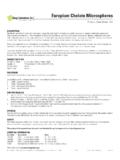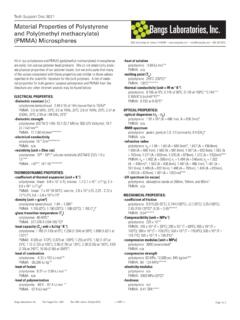Transcription of Contents
1 << COPY >>B E A D S A B O V E T H E R E S T TechNote 205 Covalent Coupling9025 Technology Dr. Fishers, IN 46038-2886 Fax IntroductionII. Binding Protocol Design and Optimization A. Reactive Groups and coupling Chemistry B. Microsphere Composition C. Reagent Quality D. Reagent Concentration E. Buffers F. Blockers G. Bead Handling H. OtherIII. Sample coupling Protocols A. Carboxyl-Modified Microspheres B. Amino-Modified Microspheres C. Hydroxyl-Modified Microspheres D. Hydrazide-Modified Microspheres E. Chloromethyl-Modified MicrospheresIV. Miscellaneous coupling Strategies A. coupling to Non-Functionalized Polymeric Microspheres B. coupling to Non-Functionalized Silica Microspheres C. Conversion of Surface Functional Groups D. Covalent Attachment of Small MoleculesV. Evaluation of the Coating ProcedureVI.
2 Recommended ReadingVII. Reagent SuppliersVII. ReferencesI. IntroduCtIonWhen coating microspheres, there are a number of strategies that may be considered, including covalent coupling , adsorption, and affinity binding. Each has its benefits and drawbacks, which should be considered in the context of research objectives, reagent requirements, technician/laboratory expertise, timetable, etc. Our TechNote 201, Working with Microspheres, provides a discussion of these different approaches. TechNote 204, Adsorption to Microspheres, and TechNote 101, ProActive Microspheres, also provide information and sample protocols that may be of help as binding strategies are coupling is often employed for the immobilization of biomolecules when a very active and stable microsphere reagent is required. For example:Bangs Laboratories, Inc. TechNote 205 Rev. #005, Active: 19/March/2013 Page 1 of 9 biomolecules are permanently bound, and will not desorb/leach over time;37 elimination of crosstalk between microspheres permits multiplexed tests and assays; ligands are favorably presented on the surface of the bead such that binding moieties are available for interaction with target molecules; binding kinetics can approach those of solution-based , 28, 47 The pages that follow contain sample coupling protocols, suggest potential points of optimization, and identify additional information resources.
3 As it would be impossible to adequately address the optimal coupling of every type of biomolecule to every type of microsphere within the scope of this TechNote, we aim to provide the investigator with a basic foundation that will aid in the development of a high quality microsphere BIndIng ProtoCol desIgn and oPtImIzatIonAlthough the general covalent coupling protocols that follow will typically result in some level of bead coating, it is expected that optimization will be required in order to achieve desired activity, performance, stability, etc. There are a number of factors and points of optimization to consider, some of which are presented in the list that follows. The amount of optimization that is deemed reasonable or necessary will likely depend upon availability of published coupling protocols, early successes/failures from use of a generic protocol and protocol objectives (required activity, stability, etc.)
4 A. Reactive Groups and coupling Chemistries1. LigandAs activity and binding kinetics are highly dependent upon orientation of the immobilized molecule, reactive groups that are available for coupling or modification should be carefully , 12, 16, 442. MicrosphereBiomolecules may be coupled to polymeric or silica microspheres through a variety of surface chemistries. Surface functional groups that are available include: polymeric - carboxyl and amino (greatest availability), as well as hydroxyl, hydrazide, and chloromethyl; and silica - silanol, carboxyl. General coupling protocols are provided in Section III of this TechNote. See Section IV, Recommended Reading, and Section VIII, References, for additional sources of information. TECH NOTE 205 Page 2 of 9 Bangs Laboratories, Inc. TechNote 205 Rev. #005, Active: 19/March/2013<< COPY >>3. Cross-Linking Reagent (Linker, Spacer, Activator)There are a number of chemical compounds that may be employed to modify or bind to the available reactive group on the bead or biomolecule.
5 Cross-linking reagents may be used to activate groups that exhibit low reactivity in an aqueous environment ( carbodiimide for binding to COOH groups), or to join groups that are simply not reactive toward one another ( NH2 to NH2). Certain types of linkers function as spacers, extending the biomolecule from the solid surface (often used in the coupling of small molecules or oligonucleotides to address steric effects).10, 20, 21, 32, 37, 38 Linkers can also simplify conjugations ( photoreactive) or confer Microsphere CompositionThe specific composition of the microsphere will determine characteristics, such as hydrophobicity or hydrophilicity, positive or negative charge, surface charge density, etc. These characteristics will have some influence on the loading capacity, , how efficiently the biomolecule will come into proximity of the chemical group so that coupling may occur. They will also affect nonspecific binding characteristics, although nonspecific binding may be addressed with blockers, buffers, test / assay conditions ( sample dilution), Reagent QualityThe quality of reagents is central to successful covalent coupling , and to the ultimate performance of the coated microsphere.
6 Manufacturer s guidelines for reagent preparation, use, storage, and expiration should be observed to ensure activity and stability, and safeguard against contamination. The quality (purity, affinity, cross-reactivity) of antibody or other capture biomolecule should be considered prior to covalent immobilization. (Does it perform well enough to warrant design and optimization of a coupling protocol?)D. Reagent Concentration1. GeneralDetermining appropriate concentrations of different reagents, such as ligand and linker, will be important in controlling surface density. Using too little may result in sub-optimal coating and low activity. Using too much may cause bead overload (steric effect, with diminished activity) or may simply waste expensive reagent. Some guidance is provided below (equation, Section VIII, References) and in the general covalent coupling protocols in Section Protein9 Covalent coupling protocols have historically focused on the binding of a monolayer of protein.
7 The amount of protein that will comprise a monolayer will depend upon factors such as the molecular weight (MW) of the protein and its relative affinity for the bead. This amount may be estimated through the use of the following equation: S = (6 / Sd)(C)where S = amount of representative protein required to achieve surface saturation (mg protein/g of microspheres), S = density of solid sphere (g/cm3), d = mean diameter ( m), and C = capacity of microsphere surface for a given protein (mg protein/m2 of sphere surface).Cantarero et provide capacity data (C) for bovine serum albumin (BSA, MW 65 kD) and bovine IgG (BIgG, MW 150 kD). By comparing the MW of your ligand to that of BSA and IgG, surface saturation of other ligands can be approximated. We base our calculations, as well as the reagent volumes listed in the coupling protocols, on microspheres with a mean diameter of m. Therefore, the calculation is carried out as follows: For BSA: C ~ 3 mg/m2, so: S = (6 / Sd)(C) = (6 / [ g/cm3 m])(3 mg/m2) ~ 18 mg of BSA to saturate 1 gram of 1 m polystyrene-based microspheres.
8 For BIgG: C ~ mg/m2, so: S = (6 / Sd)(C) = (6 /[ g/cm3 m])( mg/m2) ~ 15 mg of BIgG to saturate 1 gram of 1 m polystyrene-based microspheres. It is important to note that the resulting calculated value is considered to be a starting point in the determination of optimal protein concentration. The optimal protein concentration may be substantially higher than the monolayer value (up to 10X) if coupling efficiency is not high, or if high coating density is required ( sample contains only a trace amount of the target molecule). Conversely, much lower amounts of protein may be appropriate if high activity is not required ( flow cytometric assay with abundant target) or desired ( steric effects or increased nonspecific binding).C. Nucleic AcidThere are special considerations for the immobilization of single-stranded nucleic acid probes. As the full length of the oligonucleotide will participate in the hybridization event, high probe density on the bead surface has been associated with reduced hybridization efficiency due to steric , 41 Figure 141 illustrates the relationship between probe length and packing configuration/surface density.
9 The authors envisioned short probes packing in extended configurations, with long probes existing in more flexible, polymeric-like recently, probe density has been demonstrated to affect polymerase generic protocol for the covalent coupling of an aminated oligonucleotide to COOH-functionalized microspheres is provided in TechNote 302, Molecular Biology. Covalent nucleic acid immobilization, and strategies for addressing hybridization efficiency ( use of a linker, controlling probe density), have been documented in the literature. Although it may be necessary to determine optimal probe concentration empirically, the literature holds many references that provide guidelines. (See references 1, 2, 4, 17, 23, 27, 28, 31, 39, 42 and 45.)D. Other BiomoleculesThere are numerous published coupling protocols available for a variety of biomolecules, including peptides, haptens, hormones, drugs, etc. Investigators are encouraged to refer to the literature for guidelines on suitable biomolecule and reagent concentrations.
10 Use of the equation for Most recently, probe density has been demonstrated to affect10 Short ProbesLong ProbesFigure 1 Figure 1: Probe Length vs. Packing Configuration TECH NOTE 205 Page 3 of 9 Bangs Laboratories, Inc. TechNote 205 Rev. #005, Active: 19/March/2013<< COPY >>determination of a protein monolayer may also aid in establishing trial Buffers1. GeneralThere are a number of buffers that have been used successfully in covalent coupling reactions. The protocols that follow typically do not contain recommendations for specific buffers, as there is not a buffer that would be ideal for every scenario (ligand and reactive group). Generally, the pH at which each reaction (activation, binding, quenching, blocking) occurs will be important; recommendations are provided within the coupling protocols that follow. The compatibility of the buffer and ligand (solubility, activity) is, of course, important, and should be considered when selecting , the buffer should not contain certain compounds that will interfere or compete with the reaction or For example, phosphate and acetate buffers can reduce the reactivity of carbodiimides, and are thus not recommended for use as activation buffers when coupling to COOH-modified microspheres.







